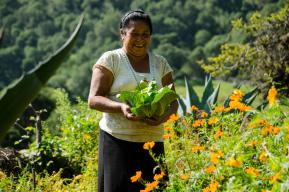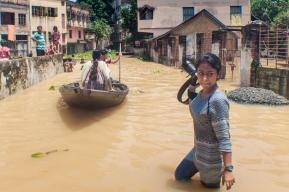Article
Mexico: Women lead the way in saving the mangroves

Alejandro Castro
Journalist in Mexico
Since she was a small child, Erika Barnett, from the Seri community in northeastern Mexico, watched mangrove seedlings be carried away by the waves. She would then gather young shoots to take back to her home on the coast.
The daughter of fishers, she is now 31 years old and the director of one of the most important coastal restoration projects in Mexico, cultivating and planting mangroves in a desert region that has one of the harshest climates in the country.
More than 18 million Mexicans live in coastal communities. In addition to the mixed-ethnicity population, four ethnic groups live along the coast: the Seri (northeast); the Mayas (southeast); the Huaves (south-central) and the Cucapás (north). What do they have in common? They all depend on natural resources, particularly mangroves, to live.
“The infrastructure, economy and food security of hundreds of coastal communities depend on these flooded forests,” says Claudia Teutli Hernández, biologist and professor at the National School of Advanced Studies of the National Autonomous University of Mexico (UNAM).
A link between land and sea
Along Mexico's 4,600-kilometre coastline, tangled roots emerge from the swampy soil. Twisted branches and evergreen leaves form labyrinths linking the land and the sea. They are mangrove forests, considered to be among the most productive ecosystems in the world.
According to the National Commission for the Knowledge and Use of Biodiversity (CONABIO), Mexico is home to six per cent of the world’s mangroves. In terms of the extent of these ecosystems worldwide, the country ranks fourth after Indonesia, Australia and Brazil.
Mangroves form a particularly precious ecosystem for coastal communities. This green belt reduces erosion of the coast by forming a protective barrier against severe weather events such as hurricanes. The roots of the mangroves, submerged in mud and brackish water, serve as nesting and survival shelters for young fish and crustaceans. Their branches are also home to various species of wildlife, including birds, monkeys and felines. Mangroves are also greenhouse gas sinks, absorbing even more carbon dioxide than tropical forests.
Mangroves form a protective barrier against severe weather events
But these woody, dense, arborescent plant formations are more and more threatened. Data from the Global Mangrove Watch platform indicates a loss of 44,788 hectares of mangroves in Mexico between 1996 and 2020.
Tourism and urban spread
“Their destruction correlates to the economic development of each region,” explains researcher Claudia Teutli Hernández. On the peninsula of the Yucatán, for example, the explosive growth of hotel complexes and urban spread are the main threat.
Holbox, an island in the Mexican Caribbean, illustrates the deterioration of the mangroves linked to the growth of tourism and real estate, the streets and construction eating away at this unique ecosystem.
Claudia Teutli Hernández also points to road infrastructure development as the reason for the destruction of mangrove ecosystems in Baja California and Baja California Sur. In the Tamaulipas region (northwest), however, the extraction of hydrocarbons is one of the main threats. In other regions like Veracruz, in the middle of the country, livestock, along with tourism, is another factor leading to deforestation.
The speed of the destruction of Mexican mangroves is much faster than the ability to restore and reestablish these ecosystems, according to Jorge Herrera Silveira, researcher at the Center for Research and Advanced Studies of the National Polytechnic Institute (IPN), Mérida Unit.
The conservation challenge is immense. In several locations across the country, communities are organizing to work on restoration, surveillance and to raise awareness. For example, Herrera Silveira has been working for ten years with 13 women on the northern coast of the Yucatán, a group known as the Chelemeras.
In several locations across the country, communities are organizing to work on the restoration and surveillance of mangroves
The group, made up of homemakers, mothers, wives and carers, has been recognized at the national level for bringing new life to 100 hectares of deteriorated mangroves in their town, Chelem. Hence the name of the collective.

The fight of the Chelemeras
Their restoration technique consists of reconnecting the hydrological systems so the mangrove can start to grow again on its own. For the last ten years, the Chelemeras have been putting on their rubber boots, hats, gloves and long-sleeved T-shirts, and sinking into the mud for more than five hours to dig ditches with picks and shovels.
The collective was born from a restoration project started by Jorge Herrera Silveira, then followed up by the women, according to Keila Vázquez, one of the managers. “It was not easy,” she admits. “The restoration efforts required funds to buy appropriate clothing, pay for travel, food, etc. The funds trickle in, sometimes from universities, other times from civil society organizations.”
At the other end of the country, in the city of La Paz, in Baja California Sur, a similar group of 14 women protects one of the last mangrove zones in the urban area. They are called the guardians of the Conchalito, another name for the mangrove. They live in El Manglito, a working-class neighbourhood located directly opposite.
To put an end to poaching in their town, these women decided to organize themselves to watch over more than 40 hectares of land which their husbands and sons could not access with their pangas (small boats), says Martha García, one of the founders. Their strength is in their numbers, she explains. In the beginning, they chased away illegal fishermen by throwing stones at them, but with time they have developed protection and restoration objectives for the area, which had become an unauthorized dumping ground.
Environmental education also plays a central role in the work of these two groups of women. It is one way to anchor their efforts to preserve the mangroves in the future.
Biosphere reserves caring for mangroves in Latin America
Since September 2022, the La Encrucijada biosphere reserve in Mexico has been spearheading a project to assess the state of mangroves and to restore them in seven biosphere reserves in Latin America and the Caribbean, located in Colombia, Cuba, Ecuador, Panama and Peru.
Latin America and the Caribbean are home to almost 26 per cent of the world's mangrove forests, but these have been in decline nearly everywhere since the 1980s. Mangroves provide crucial ecosystem services to many coastal populations, particularly indigenous ones, by serving as fish nurseries and sources of wood. They also constitute a natural coastal defence. By breaking waves, mangrove forests protect against coastal erosion and storms. In addition, they provide habitat for numerous species of birds, reptiles and amphibians and are highly effective carbon sinks.
Good news – mangroves have an exceptional capacity to restore themselves. But to do so, they need help. To achieve this end, the UNESCO project, funded by Belgium’s Government of Flanders, draws on the knowledge of local communities, indigenous peoples and scientists. In its first phase, the project will seek to ascertain the causes of mangroves’ disappearance.
At the same time, technical workshops will be organized at the local level, to determine the threats to mangrove forests and provide appropriate responses. The project also aims to identify mangrove species that can be reintroduced and the places where they can be replanted and restored, in order to initiate a cycle of natural regeneration that can be sustained over the long term.

In the same issue









